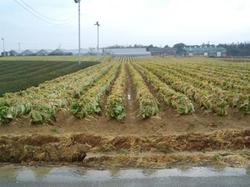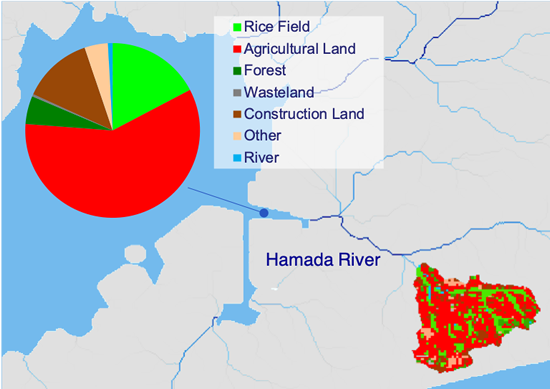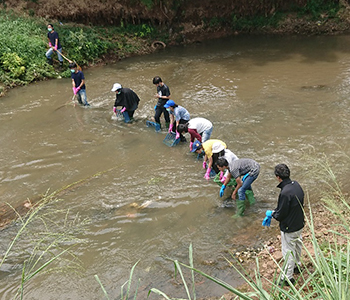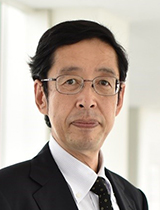
ここからコンテンツです。

Tackling Water Pollution, a Sustainable Development Goal (SDGs)
Easily and accurately measuring phosphorus, the cause of eutrophicationTakanobu Inoue

Harmful growth of phytoplankton causes the oceans and tides to turn red. Hypoxia that develops in enclosed bays creates frothy blue water. Micro-algae in lakes leads to algal growths that cover large areas of the water's surface. All of these issues indicate serious damage to water quality and lead to the mass death of marine life. This is due to eutrophication, which is caused by an imbalance in nutrients such as nitrogen and phosphorus. Among these nutrients, Professor Takanobu Inoue focuses on phosphorus. After identifying bioavailable phosphorus, he looked at actual on-the-ground conditions and devised an extremely simple and effective measurement method to help reduce runoff.
This research contributes to the achievement of the Sustainable Development Goal 14: Life below water ― Conserve and sustainably use the oceans, seas and marine resources for sustainable development.
Interview and report by Madoka Tainaka
Eutrophication: A Cause of Major Water Quality Issues
Nutrients such as nitrogen and phosphorus are essential to the survival of plants and organisms. In particular, since there is no phosphorus in the atmosphere, plants and organisms have long relied on water that contains phosphorus derived from forests, sharing these resources in a way that maintains a balanced ecosystem. However, Professor Inoue notes that in recent years, this balance has been significantly disturbed due to issues with water quality.
"Many people live on river basins, and excessive volumes of nitrogen and phosphorus flow through the rivers into enclosed bodies of water. Organic matter consumes oxygen and decomposes, and nutrients accumulate at the bottom," says Inoue. "Moreover, the consumption of oxygen results in hypoxia, which is the condition of extremely low oxygen levels. This hypoxia rises to the surface, causing blue discoloration. The high concentration of nutrients causes various problems such as red tides and algal blooms.
"In Japan, the algal bloom at Biwa Lake in the 1970s is particularly well-known. In order to address the issue and decrease the corresponding nitrogen and phosphorus, Shiga Prefecture enacted the Ordinance for the Prevention of Eutrophication of Lake Biwa in 1979, prohibiting the sale of synthetic detergents containing phosphorus along with enforcing drainage regulations on factories. The passage of this regulation led various detergent manufacturers to begin selling non-phosphate detergents, leading to the improvement of water quality nationwide. However, today, algal blooms are not just limited to Lake Biwa. Almost every year, red and blue tides occur in places like Mikawa Bay and Tokyo Bay. And it's not just Japan. Eutrophication is becoming a major environmental issue across the world," says Inoue.
Runoff from Agricultural and Urban Areas is the Cause
Ministry of the Environment regulations limiting runoff load are required in order to manage the runoff of nutrients into rivers. Runoff calculations intended for such regulations conducted in a study of Mikawa Bay revealed that the total phosphorus-generating load (t/day) in 1999 was 4.3% of domestic and industrial wastewater. In 2003, this figure dropped to 2.4%, which, along with nitrogen, marked a significant improvement.
However, measurements across multiple locations in Mikawa Bay showed that nitrogen and total phosphorus levels remain relatively unchanged, with many areas not meeting environmental standards. Why is this?
"Regulations for sewage and industrial water treatment became more stringent, and the prescribed measurement method shows the total load decreasing. However, there appears to be another factor preventing the levels from falling.

"We decided to focus on nutrient salt runoff during rain events. From 2009 to 2011, we conducted a study of the Hamada River, one of the channels flowing into Mikawa Bay. Measurements were taken at a fixed time every month and ten times after it rained. Measurement results showed that while the total phosphorus amount was 0.52% (t/km2/year) when using the prescribed measurement method, the actual value was 3.65%. In other words, phosphorus runoff was seven times the regulation load," explains Professor Inoue.
This was due to the breakdown of runoff sources. Up to that time, total load regulations assumed that approximately 90% of runoff came from discrete sources such as factory and domestic drainage. In fact, total phosphorus from diffuse sources such as agricultural and urban areas accounted for nearly 90% of runoff.
"One factor in this discrepancy is that the measurement method used for total load regulations did not alter the output levels of diffuse sources since it began in 1988. In other words, the idea that strictly regulating factory and domestic drainage would suppress eutrophication was incorrect. In particular, runoff load during rain events is believed to result in a high volume of fertilizer runoff from agricultural areas. It is also possible that livestock waste at small-scale cattle ranches flows into rivers during rain events. Runoff in urban areas is also significant. Eutrophication can only be stopped if runoff from diffuse sources can be reduced," says Inoue.
Finding out Which Particulate Phosphorus is Bioavailable
On the other hand, Professor Inoue says that while current regulations target total phosphorus, not all phosphorus is bioavailable.
"While some dissolved phosphorus in the water can be used by algae for growth, algae can use some particulate phosphorus (granular phosphorus mixed with various substances). As there is a particularly large runoff of particulate phosphorus when it rains, when it comes to eutrophication, it is critical to measure the bioavailable phosphorus. In doing so, it becomes necessary to change the way we capture it, as seen with the 3.65% measurement discovered in our previous survey of Hamada River."

Typically, particulate phosphorus is measured using a shake extraction method that takes up to 17 hours. However, Professor Inoue discovered a simple method that uses ultrasonic to divide and extract the bioavailable phosphorus from the particulate phosphorus in as little as one minute. This method was inspired by separate research, in which ultrasonic was used to extract available phosphorus in soil used by plants.
This method was used in a study of the Umeda River and the Yagyu River flowing through Toyohashi City. While total phosphorus in the Umeda River was higher, the Yagyu River had higher concentrations of bioavailable phosphorus.
"97% of the water in the Umeda River basin comes from farmland. The concentration of total phosphorus is high due to fertilizer runoff from the farmland. However, the load of dissolved phosphorus flowing into the river is not particularly high since much of the fertilizer in the soil is consumed on-site by organisms. The particulate phosphorus, coupled strongly with the iron and calcium contained in high concentrations in the soil, also cannot be used again by organisms. As such, the amount of phosphorus that can be consumed by organisms is relatively low. At the same time, the large load of particulate phosphorus that flows from forests during rain is already being used by plants and organisms, so there is little effect on eutrophication downstream.
"On the other hand, 73% of the water in the Yagyu River comes from urban areas. Since large areas are covered in asphalt, the nutrients flow straight into the rivers. This causes phytoplankton and other organic matter to grow. In other words, the concentration of bioavailable phosphorus is greater.
"It is increasingly clear that existing regulations on total phosphorus are insufficient. Moving forward, I hope to conduct a more detailed study on how organisms actually use phosphorus," says Inoue.
Professor Inoue's initiatives have shown that, despite the tendency to classify phosphorus into one category, there are significant differences in the ratio of bioavailable phosphorus depending on each region's characteristics.
Solving water problems is one of the SDGs adopted by the United Nations, and dealing with eutrophication is an urgent issue. Moving forward, it will be necessary to review the measurement methods of regulation loads and implement policies based on actual on-the-ground conditions.
Reporter's Note
Takanobu Inoue was born in Otsu, Shiga Prefecture. As a high school student, he witnessed issues with Biwa Lake's water quality. Hoping to help, he entered Hokkaido University's Department of Sanitary Engineering. Beginning by focusing on the impact to the ecosystem, he then shifted to a focus on human health, one of the original goals of sanitary engineering.

"Half of the students in the lab are foreign exchange students from Asia. Their home countries are dealing with problems such as mercury poisoning from gold mining and E. coli in drinking water. I am involved in working with the foreign exchange students on related studies.
"This year, we began a study examining the amount of plastic flowing into the ocean in Indonesia. In looking at issues such as how to limit the source for microplastics, it is clear that we have a significant mission in our society," says Inoue. I have kept the same goal since I was a high school student. I am still working every day to improve our water.
水環境問題の解決でSDGsの達成に貢献
富栄養化の原因となるリンをより簡便に正確に計測植物プランクトンの異常増殖により海水や湖水が赤く変色する赤潮や、閉鎖的な内湾などで発生した貧酸素水塊によって海水などが白濁する苦潮(青潮)、湖沼などで微細藻類が大量発生して水面を覆い尽くすアオコ(青粉)――いずれも、魚介類の大量死などを招く深刻な水質汚染である。その原因は、窒素やリンなどの栄養塩類による富栄養化にある。井上隆信教授は、栄養塩のうち、とくにリンに着目して、生物が利用可能なリンを見分け、実態に即した排出削減などに役立てるために、極めて有効で簡便な計測方法を見出した。
深刻な水質問題の原因となる富栄養化
窒素やリンなどの栄養塩は、そもそも動植物の生存に欠かせない物質である。とくにリンは大気中には存在しないため、動植物は太古の昔から森林などから流出したリンが含まれる水を利用して、それぞれ分け合いながら、生態系のバランスを保ってきた。しかし、近代以降、そのバランスが大きく崩れたことが、現代の水質問題を生んできたと、井上隆信教授は指摘する。
「河川流域に多くの人が住み、河川を通じて閉鎖性水域へ多くの窒素やリンが過剰に流入し、有機物が酸素を消費して分解して栄養塩類が底に溜まります。さらにこれが酸素を消費するため、極端に酸素の少ない貧酸素水塊が発生します。この貧酸素水塊が表層に上がってくることで、苦潮が生じたり、栄養塩濃度が高くなることで赤潮やアオコが発生するといったさまざまな問題が噴出するようになってきました。
日本ではとくに1970年代の琵琶湖のアオコ問題が有名です。この問題を受けて、原因物質である窒素やリンの排出を減らすため、滋賀県は1979年に「琵琶湖富栄養化防止条例」を制定し、工場などへの排水規制と合わせて、リンを含む合成洗剤の販売を禁止しました。これがきっかけとなって、各洗剤メーカーが無リン洗剤を発売するようになり、水質は全国的に改善に向かったように見えます。しかし、いまも琵琶湖のアオコに限らず、三河湾でも東京湾でも、毎年のように赤潮や苦潮が発生している。日本だけでなく、富栄養化は世界的にも深刻な環境問題となっています」
農耕地や市街地からの流入が原因
そのために必要な措置が、栄養塩を河川などに流入させないための環境省の総量規制である。三河湾流域の調査における総量規制の算定法による結果では、平成11年の全リン発生負荷量(t/日)は、生活排水や産業排水などを合わせ4.3%だったが、平成15年では2.4%と、窒素同様にかなり減った結果となっている。
一方で、実際の三河湾数カ所での実測値では、窒素も全リンの濃度も横ばいのままであり、環境基準を満たさない水域が多くを占めた。これはなぜか。
「下水処理や産業系の処理水の基準は厳しくなっているので、総量規制の計算上は減っていることになっていますが、別の要因で減っていないことが考えられます。
そこで我々が着目したのが、降雨に伴う栄養塩類の流入です。三河湾に流入する河川の一つである浜田川を対象に、2009年から2011年まで、月1の定期検査と降雨時に10回の調査を行いました。その結果、全リンについては、総量規制の算定法による負荷量(t/km2/年)が0.52%であるのに対して、実測値では3.65%であることがわかりました。つまり、総量規制の7倍ものリンが流入していたのです」と井上教授は説明する。
その理由は、排出源の内訳にあった。これまで総量規制では工場排水や生活排水など「点源」と呼ばれる排出源が約9割を占めるとみなしてきたが、実際には、農耕地や市街地など「面源」と呼ばれる排出源からの全リンの流入が9割近くを占めていたのである。
「これは、総量規制の算定法が、1988年の開始当初から面源の原単位が変更されていないことが一因です。つまり、工場排水や生活排水の規制を厳しくすれば富栄養化が抑制できるという考え方自体が間違いでした。とくに降雨時には、農耕地から肥料が大量に流出することが考えられますし、小規模な畜産場では、糞尿が降雨時に河川に流入している可能性があります。市街地からの流入もかなりある。面源から入ってくる流入量を減らさない限り、富栄養化に歯止めはかかりません」
懸濁態リンのうち生物利用可能態リンを明らかに
一方で、井上教授は、総量規制では全リンが対象とされているが、リンのすべてが生物に利用されるわけではない、と言う。
「水中のリンのうち、溶存態リンは生物が増殖に利用できる生物利用可能態リンですが、懸濁態リン、つまりさまざまな物質と結合した顆粒状のリンについては、生物が利用できるのは一部です。とくに降雨時には懸濁態リンが大量に流入するため、富栄養化の観点から見れば、生物利用可能態リンの計測が重要になる。そうなると、先の浜田川の調査で明らかにした3.65%という数字についても、捉え方を変える必要があります」
従来、懸濁態リンの計測には、17時間にもおよぶ振とう抽出法が採用されてきたが、井上教授は懸濁態リンから生物利用可能態リンだけを抽出する方法として超音波を用いて、わずか1分間程度の分解・抽出ができる簡便な手法を見出した。この手法は、別の研究の際、植物が活用する土壌の「可給態リン」の抽出に用いる超音波法からヒントを得たものだという。
この方法を使い、豊橋市を流れる梅田川や柳生川で調べたところ、全リンでは梅田川のほうが比率は高かったが、生物利用可能態リンの観点では、柳生川の方が比率が高いことがわかった。
「梅田川流域は97%が農地で、農地から流入する肥料などによる影響から全リンで見れば比率が大きくなります。ところが、土壌に撒かれた肥料の多くはその場で生物に利用されるため河川に流出する溶存態リンの量はさほど多くはなく、土壌には鉄やカルシウムが多く含まれていて、これらと強く結合した懸濁態リンもまた生物には利用されないので、生物利用可能という観点で見れば比率が少なくなるのでしょう。同様に、降雨時には森林からも懸濁態リンが大量に流入しますが、すでに生物や植物に使われているため、下流の富栄養化にはほとんど影響しません。
一方、柳生川流域は73%が市街地であり、アスファルトに覆われた地域が多いため、栄養塩はそのまま河川に流入します。これにより植物プランクトンなどの有機物が増殖する。つまり生物に利用されるリンの比率が多くなる、と考えられます。
そうなるとますます、従来の全リンによる総量規制では対策が不十分であることがわかります。今後はさらに、実際に生物にどの程度、リンが利用されているのか詳細に調べたいと思っています」と井上教授は語る。
このように、井上教授らの取り組みにより、一口にリンといっても、地域の特性ごとに、生物利用可能態リンの割合には大きな違いがあることが解明されつつある。
水環境問題の解決は、国連が掲げるSDGsの一つでもあり、富栄養化対策は喫緊の課題である。今後は総量規制の算定法の見直しも含めて、より実態に即した対策を打っていく必要があるだろう。
(取材・文=田井中麻都佳)
取材後記
滋賀県大津市出身の井上教授。ちょうど高校生の頃に、琵琶湖の水質問題に直面し、その改善に貢献したいと、北海道大学衛生工学科へ進学したという。当初は生態系への影響を対象としていたが、しかしいまは、衛生工学が当初目的としていた人の健康を対象にし始めている。
「研究室はアジアからの留学生が半数を占めていますが、そうした国々では、鉱山での採掘に伴う水銀被害や飲料水の大腸菌汚染などが問題となっています。そうした調査も留学生とともに手がけています。
今年から、インドネシアで海洋へのプラスチックの流出量を調べる調査も始めました。問題となっているマイクロプラスチックの元をいかに防ぐのか、社会的使命は大きいと思っています」と井上教授。高校生のときに抱いた志はいまも変わることなく、水環境の改善に日々、努めている。
Researcher Profile

Dr. Takanobu Inoue
Dr. Takanobu Inoue received his M.S. and PhD degree in engineering in 1986 and 1996 respectively from Hokkaido University, Japan. He was researcher in 1986 and senior researcher in 1994 at National Institute for Environmental Studies. In 2000, he joined Gifu University as a assosiate professor. Since he started his career at Toyohashi University of Technology in 2004, had been involved in water environment engineering and sanitary engineering. He is currently a professor at the Department of Architecture and Civil Engineering, Toyohashi University of Technology.
Reporter Profile

Madoka Tainaka is a freelance editor, writer and interpreter. She graduated in Law from Chuo University, Japan. She served as a chief editor of "Nature Interface" magazine, a committee for the promotion of Information and Science Technology at MEXT (Ministry of Education, Culture, Sports, Science and Technology).
ここでコンテンツ終わりです。
